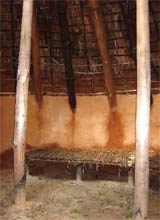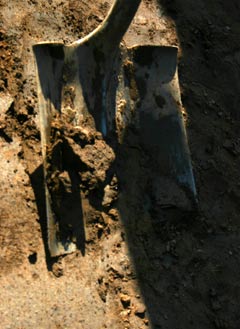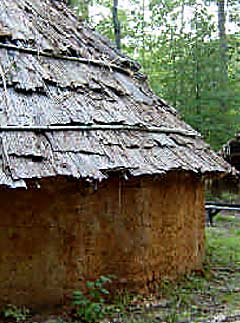A multiple choice quiz plus short answers
Start on this page by reviewing the information on the way early Native Americans lived, and how that translates to features left behind that give archaeologists a picture of a long-ago time.
Then, when you're ready to answer some questions, click here to begin a quiz with 5 multiple choice questions, and then click here to work on a series of short answer questions—just click for the answers (but answer for yourself first!)
Wattle and daub

“As they usually build on rising ground, the floor is often a yard lower than the earth, which serves them as a breast work against an enemy...”
“...they fix deep in the ground, a sufficient number of strong forked posts, at a proportional distance, in a circular form, all of an equal height, about five or six feet above the surface of the ground...Then in the middle...they fix very deep in the ground, four large pine posts, in a quadrangular form, notched a-top, which they lay a number of heavy logs...The inside of their houses is [sic] furnished with genteel couches to sit, and lie upon...to give the swarming fleas some trouble in their attack...”
This Old House
Did you know that 2,000 years ago Native Americans who lived in what is now the Southeastern United States did not live in tee-pees? They built summer and winter homes adapted to the environment. These styles of houses worked so well that Native Americans used them for over 2,500 years, from around 1000 B.C. to after the 1550s A.D.!
Winter homes were sturdy and so well constructed that European explorers reported that the houses, “...retain and reflect the heat, after the manner of the Dutch stoves”. While these clay and wood houses (called “wattle and daub”) kept Native Americans warm in winter, other homes served their summer needs. Light, pole-frame, open-air structures provided breezy shelters from rain and harsh summer sun.

This is the way archaeologists see Native American houses—as stains in the soil that provided important clues to the size and shape of the house.
Original wattle and daub houses are not still standing from 2,000 years ago. But they have survived! By doing careful, scientific excavation, archaeologists can locate where these homes once stood. They excavate the homes to uncover information about how the Native Americans lived in the distant past. Would you make a good archaeologist? Take the quiz!


